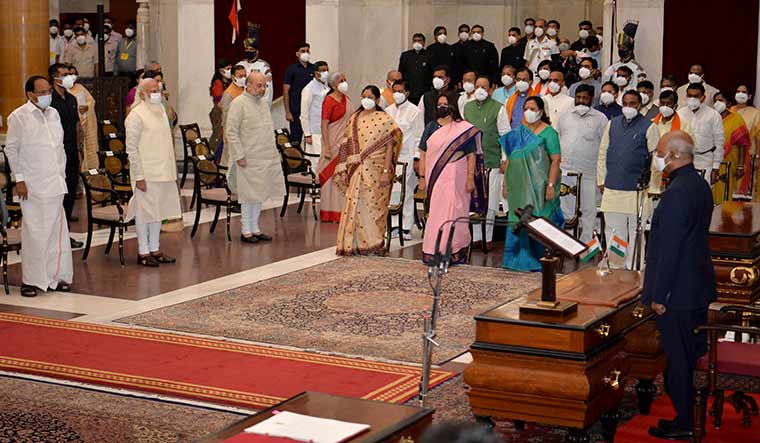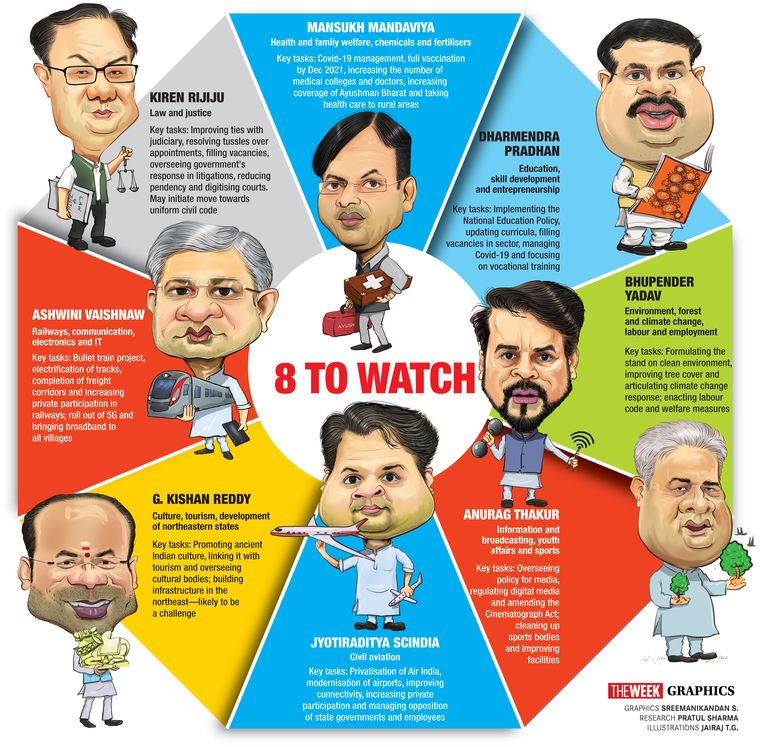The year 2022 is a year of deadlines. Prime Minister Narendra Modi had promised to usher in a “New India” by the time the country celebrates its 75th year of independence. From doubling of farmers' income to sending an Indian to outer space in an indigenous spacecraft, the BJP had made 75 ambitious promises in its 2019 elections manifesto. The prime minister had promised to fulfil them by 2022.
Modi 2.0 has so far delivered on several of its ideological poll promises—for instance, abrogation of Article 370, abolition of triple talaq and bringing the Citizenship Amendment Act. But its promises to provide better infrastructure and turn the economy around have lagged.
On the economy front, the recovery and employment generation has been slow, though the Reserve Bank of India in its June bulletin saw reasons to be “cautiously optimistic”. A rampaging Covid-19 worsened the existing vulnerabilities of the economy. To revive the economy, the government needs successful management of Covid-19, capital expenditure on infrastructure, disinvestment, fast implementation of reforms, and new policies in the social and corporate sectors. Fulfilling the 2022 targets is crucial before the prime minister could go back to the people with a report card.
To make this possible, Modi initiated a major revamp of his team by booting out 12 cabinet ministers. He brought in 36 new faces and promoted seven ministers to cabinet rank. The intent was both political and governance-oriented as it balanced caste equations in the poll-bound states. Modi's induction of new faces in key portfolios like health, education, railways and IT showed that he wanted to shake off inertia and focus on delivery.
The cabinet expansion brings new performers to the centre stage, who may be politically less visible; they need to get the work done, while the challenge of winning elections will be left to Modi-Shah's charisma and strategic planning. Defence Minister Rajnath Singh, Home Minister Amit Shah, Finance Minister Nirmala Sitharaman and External Affairs Minister S. Jaishankar retained their respective portfolios. This means security and finance, the two key pillars, were kept untouched, while the other two—infrastructure and the social sector—were completely revamped.
“It is a big message,” said the BJP spokesperson Gopal Krishna Agarwal. “There are several challenges post-Covid, especially on the economic front which needed a focused approach at the implementation level. This required certain talent, new zeal and enthusiasm.”
Modi’s surprise pick was Mansukh L. Mandaviya, a low-key party leader from Gujarat, who was promoted within the cabinet to run the health ministry—perhaps, the hottest seat in the country now. Mandaviya was also given charge of the chemicals and fertilisers ministry to bring synergy between the health and pharmaceutical industry. What is interesting to note is that only Dr Harsh Vardhan has been given the boot, while all the bureaucrats and officials who were handling Covid management through different panels have been retained. With the third wave of Covid-19 supposedly in the offing, Mandaviya will be tested soon. He needs to fulfil the promises of completing India’s vaccination drive by December 2021 and establishing 75 new medical colleges by 2022.
A key trick to prolong the stay in Modi’s cabinet was to remain controversy-free and also not run for the limelight. During the first meeting with his council of ministers, Modi advised the newcomers not to run after publicity, but to focus on the delivery, a message he has consistently conveyed to his party MPs. Those who adhered to it have got seats in his team.
The amenable Kiren Rijiju will helm the law ministry, which is considered a fiefdom of veteran lawyers-turned-politicians. Rijiju holds a law degree from Delhi University. The promotion has come for him as he ran a controversy-free tenure since Modi 1.0.
Another surprise inclusion has been Ashwini Vaishnaw, a former IAS officer of the 1994 batch. Modi and Shah had personally called up Odisha Chief Minister Naveen Patnaik to help him get elected to Rajya Sabha. Patnaik was favourably disposed towards the former bureaucrat who had efficiently handled many crises in the state, including cyclones. Vaishnaw, an alumnus of IIT Kanpur and Wharton Business School, Pennsylvania, is expected to bring railways on track as it suffered losses during the pandemic, and fast-track high-speed corridors. At the information technology and communications ministry, Vaishnaw’s role will be to help the rollout of the 5G network, bringing broadband to the villages, and, of course, handle social media giants with finesse—unlike his predecessor Ravi Shankar Prasad, who had assumed a threatening tone.
The BJP has inducted a record number of dalits, tribals, OBCs and women as ministers after the cabinet reshuffle. There are 12 ministers from scheduled castes—two with cabinet rank—eight from scheduled tribes and 27 from other backward classes. Eleven women are also now part of the Union government. Modi inducted allies from the Janata Dal (United) and the Apna Dal, Lok Janshakti Party to give a larger message of political engagement ahead of 2024 polls.
Predictably, with elections to seven states scheduled for next year, these states have been given adequate representation. Uttar Pradesh got the highest share with eight ministers, Gujarat six, one each from Himachal Pradesh, Manipur and Uttarakhand. Hardeep Singh Puri, the Sikh face in the government, was promoted to cabinet rank as Punjab goes to assembly polls next year. He retained the urban affairs ministry that is involved in the redevelopment of the Central Vista. Modi-Shah's trusted election management expert, Bhupender Yadav, will helm environment and labour, the two ministries needed for pushing reforms in the corporate sector. As the country goes for a big infrastructure push, the role of the green ministry becomes important in safeguarding the environment, while at the same time handling permissions. He is the first Yadav cabinet minister in the Modi government, whose elevation is seen as a signal to the crucial vote bank in Uttar Pradesh, Bihar and Haryana.
Jyotiraditya Scindia’s entry into the cabinet was expected, after he helped bring down the Congress government in Madhya Pradesh. As civil aviation minister, a post once held by his father Madhavrao Scindia, he is expected to push for disinvestment of Air India, improve air connectivity among states and modernise the airports.
A big gainer in this reshuffle is Dharmendra Pradhan, as he will helm the education ministry, which has witnessed many ministers in the last seven years. Smriti Irani, Prakash Javadekar and Ramesh Pokhriyal had earlier held the portfolio, but could not manage to win the trust of sangh affiliates who wanted quick and drastic changes in the education segment.
As Dr Harsh Vardhan got dropped, Meenakshi Lekhi, who represents the New Delhi Lok Sabha constituency, has been made a minister of state (MoS). The key inclusions as MoS include Rajeev Chandrasekhar, Anupriya Patel from Apna Dal, OBC leader S.P. Singh Baghel and B.S. Yediyurappa acolyte Shobha Karandlaje. The BJP rewarded its Tamil Nadu state president, L. Murugan, too, with a ministerial position for the party’s good show in the recent assembly elections.
The changes in the cabinet have to be read along with new governor appointments that preceded it. Dalit leader Thawar Chand Gehlot, former minister of social justice and empowerment, took over in Karnataka, Goan leader Rajendra Arlekar in Himachal Pradesh and Mangubhai C. Patel, a tribal leader from Gujarat, in Madhya Pradesh. Both Gujarat and Goa will have assembly elections next year.
Congress spokesperson Randeep Surjewala described the cabinet reshuffle as a defector adjustment expansion. “If performance and governance were the criteria, then Defence Minister Rajnath Singh would have been sacked for Chinese intrusion; Home Minister Amit Shah for failing to control terrorism, Naxalism and mob lynching; and Finance Minister Nirmala Sitharaman for bringing down the GDP growth from 8 per cent to -8 per cent,” he says.
The BJP counters the criticism. “The prime minister’s approach is to make a matrix of performance and accountability,” says Agarwal. “Before there was no accountability.”
As the Union government enters a challenging phase, it has kept its eyes on reforming another sector—cooperatives. It comes with a lot of political intent, as Home Minister Shah will handle the newly-crafted ministry. However, the opposition parties see the creation of this ministry as another attack on the federal rights of the states.
While cooperative societies are a state subject, the Union government can formulate rules and policies for the sector, which has a direct connection with the urban and rural poor. There are over 8.5 lakh cooperative societies with a membership of over 28 crore people. The 97th Constitutional Amendment Act, 2011—related to the working of cooperative societies—had given the Centre the power to define its role. The matter is now under the consideration of the Supreme Court as the amendment was challenged saying it violated the federal structure. Various political parties have already questioned the motives of the government. They are likely to ask Shah to make the contours of the new ministry clear in the upcoming Parliament session.




